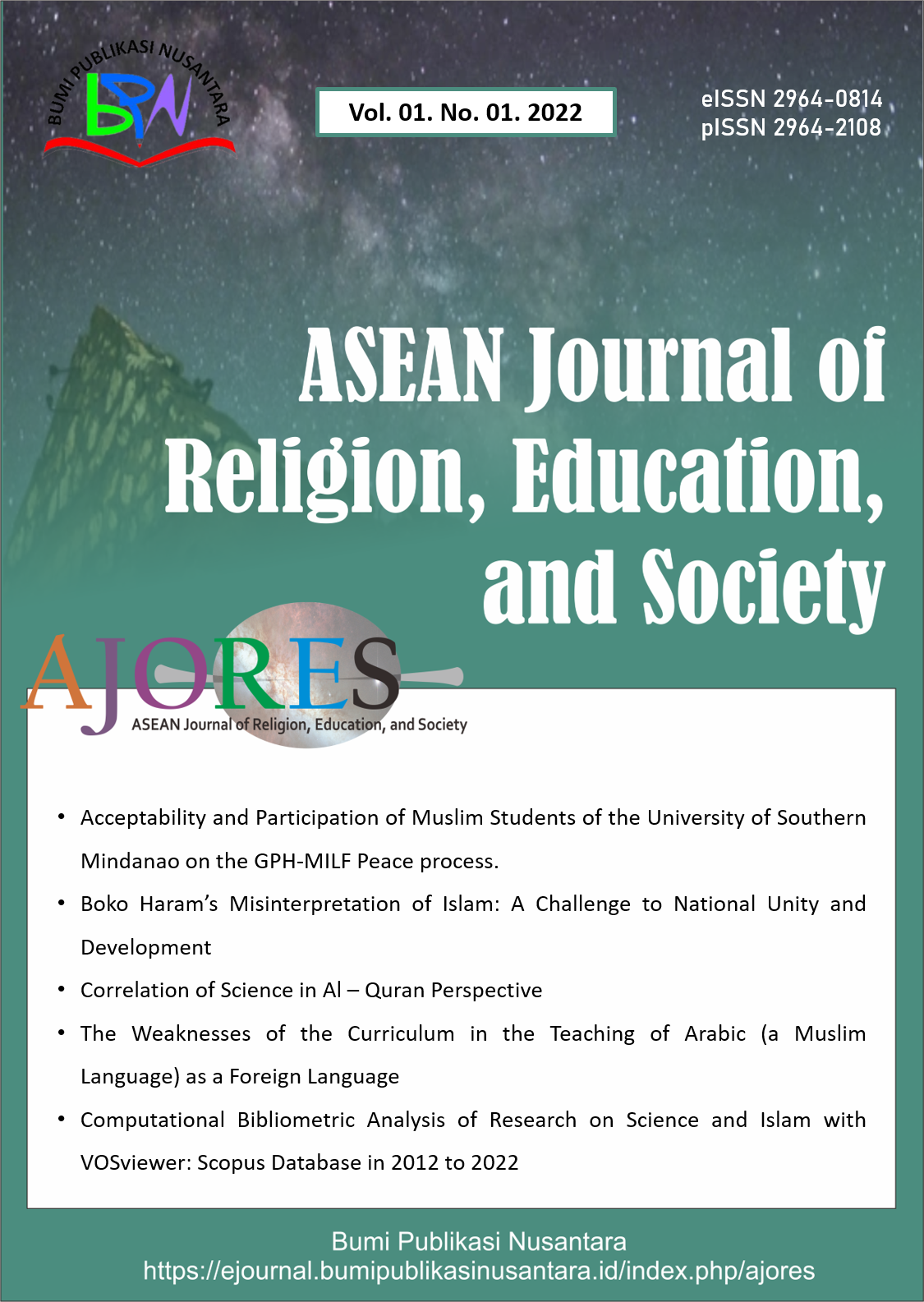Understanding Cultural Competence in Non-Muslim Nurses Caring for Muslim Patients in the Philippines
 ),
),
(1) Sultan Kudarat State University
 Corresponding Author
Corresponding Author
Abstract
Keywords
References
Alizadeh, S., and Chavan, M. (2016). Cultural competence dimensions and outcomes: a systematic review of the literature. Health & Social Care in The Community, 24(6), e117-e130.
Alosaimi, D., Dyson, S., and Anthony, D. (2013). A phenomenological study of non-muslim nurses experiences of caring for muslim patients in Saudi Arabia. International Journal of Arts & Sciences, 6(2), 637.
AlYateem, S., and Al-Yateem, N. (2014). The experience of overseas nurses caring for Muslim patients in Kingdom of Saudi Arabia and UAE: a qualitative study. International Journal of Research in Nursing, 5(1), 17-26.
Anderson, L. M., Scrimshaw, S. C., Fullilove, M. T., Fielding, J. E., and Normand, J. (2003). Culturally competent healthcare systems: A systematic review. American Journal of Preventive Medicine, 24(3), 68-79.
Andrews, M. M. (2003). Culturally competent nursing care. Transcultural Concepts in Nursing Care, 4, 3-73.
Archuleta, S., Ibrahim, H., Pereira, T. L. B., and Shorey, S. (2024). Microaggression interactions among healthcare professionals, trainees and students in the clinical environment: A mixed-studies review. Trauma, Violence, & Abuse, 25(5), 3843-3871.
Bauce, K., Kaylor, M. B., Staysniak, G., and Etcher, L. (2023). Use of theory to guide integration of virtual reality technology in nursing education: A scoping study. Journal of Professional Nursing, 44, 1-7.
Beach, M. C., Price, E. G., Gary, T. L., Robinson, K. A., Gozu, A., Palacio, A., and Cooper, L. A. (2005). Cultural competence: A systematic review of health care provider educational interventions. Medical Care, 43(4), 356-373.
Campinha-Bacote, J. (1999). A model and instrument for addressing cultural competence in health care. Journal of Nursing Education, 38(5), 203-207.
Campinha-Bacote, J. (2002). The process of cultural competence in the delivery of healthcare services: A model of care. Journal of Transcultural Nursing, 13(3), 181-184.
Capell, J., Dean, E., and Veenstra, G. (2008). The relationship between cultural competence and ethnocentrism of health care professionals. Journal of Transcultural Nursing, 19(2), 121-125.
Caricati, L., Dicembrino, R. B., Gionti, L., Petre, L., and Ungurean, L. (2015). Cultural competence assessment instrument: Initial Italian validation and proposed refinement. Acta Biomed, 86(2), 142-149.
Chapman, R., Martin, C., and Smith, T. (2014). Evaluation of staff cultural awareness before and after attending cultural awareness training in an Australian emergency department. International Emergency Nursing, 22(4), 179-184.
Charles, C. E., and Beth Daroszewski, E. (2011). Culturally competent nursing care of the Muslim patient. Issues in Mental Health Nursing, 33(1), 61-63.
Cicolini, G., Della Pelle, C., Comparcini, D., Tomietto, M., Cerratti, F., Schim, S. M., and Simonetti, V. (2015). Cultural competence among Italian nurses: A multicentric survey. Journal of Nursing Scholarship, 47(6), 536-543.
Cooper, M., Grywalski, M., Lamp, J., Newhouse, L., and Studlien, R. (2007). Enhancing cultural competence: a model for nurses. Nursing for Women's Health, 11(2), 148-159.
Cruz, J. P., Estacio, J. C., Bagtang, C. E., and Colet, P. C. (2016). Predictors of cultural competence among nursing students in the Philippines: A cross-sectional study. Nurse Education Today, 46, 121-126.
Davidhizar, R., and Vance, A. (1999). Restructuring clinical time to professionalize the RN-BSN student. The Health Care Manager, 17(3), 26-32.
Delgado, D. A., Ness, S., Ferguson, K., Engstrom, P. L., Gannon, T. M., and Gillett, C. (2013). Cultural competence training for clinical staff: Measuring the effect of a one-hour class on cultural competence. Journal of Transcultural Nursing, 24(2), 204-213.
Domocmat, M. C. L. (2016). Nurses’ competency in caring for muslim patients. In Journal of International Scholars Conference-Allied Health, 1(5), 136-149.
Doorenbos, A. Z., Schim, S. M., Benkert, R., and Borse, N. N. (2005). Psychometric evaluation of the cultural competence assessment instrument among healthcare providers. Nursing Research, 54(5), 324-331.
Douglas, M. K., Pierce, J. U., Rosenkoetter, M., Pacquiao, D., Callister, L. C., Hattar-Pollara, M., and Purnell, L. (2011). Standards of practice for culturally competent nursing care: 2011 update. Journal of Transcultural Nursing, 22(4), 317-333.
Douglas, M. K., Rosenkoetter, M., Pacquiao, D. F., Callister, L. C., Hattar-Pollara, M., Lauderdale, J., and Purnell, L. (2014). Guidelines for implementing culturally competent nursing care. Journal of Transcultural Nursing, 25(2), 109-121.
Drame, I., Wingate, L. M., Unonu, J., Turner, M., Taylor, M. D., Bush, A., and Cawthorne, T. A. (2021). The association between students' emotional intelligence, cultural competency, and cultural awareness. Currents in Pharmacy Teaching and Learning, 13(9), 1146-1152.
du Preez, A. (2012). Understanding the phenomenon of dikgaba and related health practices in pregnancy: A study among the Batswana in the rural North West Province in South Africa. Evidence Based Midwifery, 10(1), 29.
Foronda, C. L. (2008). A concept analysis of cultural sensitivity. Journal of Transcultural Nursing, 19(3), 207-212.
Giger, J. N., and Davidhizar, R. (2002). Culturally competent care: Emphasis on understanding the people of Afghanistan, Afghanistan Americans, and Islamic culture and religion. International Nursing Review, 49(2), 79-86.
Glass, P. E. S. (2013). Differences among undergraduate and graduate nursing students’ cultural competency. Differences, 7, 2-2013.
Halligan, P. (2006). Caring for patients of Islamic denomination: critical care nurses’ experiences in Saudi Arabia. Journal of Clinical Nursing, 15(12), 1565-1573.
Hussein, F. M. (2013). Relationship between structural empowerment, work engagement, and job satisfaction among nursing staff at Zagazig University Hospitals. Zagazig Nursing Journal, 9(1), 15-30.
Jaber, L. A., Pinelli, N. R., Brown, M. B., Funnell, M. M., Anderson, R., Hammad, A., and Herman, W. H. (2011). Feasibility of group lifestyle intervention for diabetes prevention in Arab Americans. Diabetes Research and Clinical Practice, 91(3), 307-315.
Jackson, A. K. (2007). Cultural competence in health visiting practice: A baseline survey. Community Practitioner, 80(2), 17-22.
Jongen, C., McCalman, J., and Bainbridge, R. (2018). Health workforce cultural competency interventions: a systematic scoping review. BMC Health Services Research, 18, 1-15.
Kawaguchi-Suzuki, M., Hogue, M. D., Khanfar, N. M., Lahoz, M. R., Law, M. G., Parekh, J., and Van Thang, V. (2019). Cultural sensitivity and global pharmacy engagement in Asia: India, Indonesia, Malaysia, Philippines, and Vietnam. American Journal of Pharmaceutical Education, 83(4), 7215.
Kelly, F., and Papadopoulos, I. (2009). Enhancing the cultural competence of healthcare professionals through an online course. Diversity in Health & Care, 6(2), 77-84.
Kitota, A. M. (2023) Uncovering the medical implications from maxims of prophet muhammad (saw) on general hygiene, health and diseases: A case of infectious diseases. International Journal of Research Publication and Reviews, 4, 296-313.
Leininger, M. (2002). Culture care theory: A major contribution to advance transcultural nursing knowledge and practices. Journal of Transcultural Nursing, 13(3), 189-192.
Mohamed, C. R., Nelson, K., Wood, P., and Moss, C. (2015). Issues post-stroke for Muslim people in maintaining the practice of salat (prayer): A qualitative study. Collegian, 22(3), 243-249.
Noll, G. (2014). Weaponising neurotechnology: international humanitarian law and the loss of language. London Review of International Law, 2(2), 201-231.
O’Neill, F. (2011). From language classroom to clinical context: The role of language and culture in communication for nurses using English as a second language: A thematic analysis. International Journal of Nursing Studies, 48(9), 1120-1128.
Ordonez, R. V., and Gandeza, N. (2004). Integrating traditional beliefs and modern medicine: Filipino nurses’ health beliefs, behaviors, and practices. Home Health Care Management and Practice, 17(1), 22-27.
Padela, A. I., Killawi, A., Heisler, M., Demonner, S., and Fetters, M. D. (2011). The role of imams in American Muslim health: perspectives of Muslim community leaders in Southeast Michigan. Journal of Religion and Health, 50, 359-373.
Paez, K. A., Allen, J. K., Beach, M. C., Carson, K. A., and Cooper, L. A. (2009). Physician cultural competence and patient ratings of the patient-physician relationship. Journal of General Internal Medicine, 24, 495-498.
Papadopoulos, I., and Lees, S. (2002). Developing culturally competent researchers. Journal of Advanced Nursing, 37(3), 258-264.
Renzaho, A. M. N., Romios, P., Crock, C., and Sønderlund, A. L. (2013). The effectiveness of cultural competence programs in ethnic minority patient-centered health care—a systematic review of the literature. International Journal for Quality in Health Care, 25(3), 261-269.
Rothlind, E., Fors, U., Salminen, H., Wändell, P., and Ekblad, S. (2018). Circling the undefined—A grounded theory study of intercultural consultations in Swedish primary care. Plos One, 13(8), e0203383.
Schim, S. M., and Doorenbos, A. Z. (2010). A three-dimensional model of cultural congruence: Framework for intervention. Journal of Social Work in End-Of-Life & Palliative Care, 6(3-4), 256-270.
Schim, S. M., Doorenbos, A. Z., and Borse, N. N. (2005). Cultural competence among Ontario and Michigan healthcare providers. Journal of Nursing Scholarship, 37(4), 354-360.
Schim, S. M., Doorenbos, A. Z., and Borse, N. N. (2006a). Cultural competence among hospice nurses. Journal of Hospice & Palliative Nursing, 8(5), 302-307.
Schim, S. M., Doorenbos, A. Z., and Borse, N. N. (2006b). Enhancing cultural competence among hospice staff. American Journal of Hospice and Palliative Medicine®, 23(5), 404-411.
Schim, S. M., Doorenbos, A., Benkert, R., and Miller, J. (2007). Culturally congruent care: Putting the puzzle together. Journal of Transcultural Nursing, 18(2), 103-110.
Snyder, M., and Niska, K. (2003). Cultural related complementary therapies: Their use in critical care units. Critical Care Nursing Clinics, 15(3), 341-346.
Starr, S., and Wallace, D. C. (2009). Self‐reported cultural competence of public health nurses in a Southeastern US Public Health Department. Public Health Nursing, 26(1), 48-57.
Walkowska, A., Przymuszała, P., Marciniak-Stępak, P., Nowosadko, M., and Baum, E. (2023). Enhancing cross-cultural competence of medical and healthcare students with the use of simulated patients—a systematic review. International Journal of Environmental Research and Public Health, 20(3), 2505.
Weech-Maldonado, R., Elliott, M., Pradhan, R., Schiller, C., Hall, A., and Hays, R. D. (2012). Can hospital cultural competency reduce disparities in patient experiences with care?. Medical Care, 50, S48-S55.
Article Metrics
Abstract View : 1009 times
: 1009 times Download : 568 times
Download : 568 times
Refbacks
- There are currently no refbacks.
Copyright (c) 2025 Bumi Publikasi Nusantara

This work is licensed under a Creative Commons Attribution-ShareAlike 4.0 International License.







